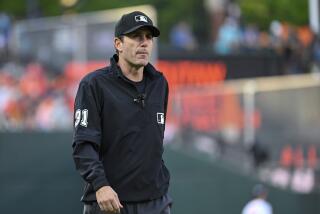Officiating Crew Is Making Waves : Debut of On-Water Referees for America’s Cup Produces Some Controversial Rulings
- Share via
SAN DIEGO — “Negative 10!” the radio crackles.
“I’m still clear ahead,” says another voice.
“I’m going to be squeezed out if I’m not careful,” says a third.
“Negative 15!”
“You’re safe . . . you’re safe.”
It’s the sound of sport’s new officiating: on-water umpiring for sailboat racing and a controversial addition to this America’s Cup. It nearly cost Dennis Conner a place in the defender finals and cost New Zealand a one-second victory over Italy’s Il Moro di Venezia three weeks ago, when it was ruled the Kiwi boat touched the buoy at one end of the finish line.
Each match is shadowed by two small power boats, one with two umpires in pink caps and the other with one or two “wing” judges in bright green caps, off to one side.
When the race boats are close, they talk constantly, with one umpire taking the part of each boat as situations develop, while the wing judge feeds them running information on overlaps that are critical to the right-of-way rules--”negative 15,” for example, meaning the boats are still 15 feet apart, bow to stern.
The fundamentals are the same as for any other sports officials: concentration, anticipation, position.
The most important difference is that, except when they see a boat touch a mark of the course, sailing umpires don’t initiate calls but merely watch for fouls and wait for one of the competitors to wave a protest flag: the nautical code flag for “Y,” with red and yellow diagonal stripes.
The umpires--not the wing judges--will respond by waving the colored identification flag of the guilty party, which is required to execute a penalty turn. Or they will show a green flag indicating there was no foul.
Conner has said, “I think the only flags the umpires have are green.”
There is no recourse, no appeal. All decisions are final.
It’s not a perfect system, but the competitors agree that it’s better than the alternative: protest hearings, not unlike criminal trials, extending late into the night, and presided over by jurors who might have been having lunch at the yacht club when the incident took place miles away at sea.
Then, it’s not always a matter of who was guilty, but who argues their case the best.
Conner has said, “I’ve never been thrilled with on-water umpiring. The other system was just fine. (Stars & Stripes tactician) Tom (Whidden) and Dennis are a formidable pair in the protest room. Now that is an advantage taken away.”
This way, even a guilty sailor can pay his fine and keep racing--perhaps even win.
Tom Ehman, executive vice president and general manager of the America’s Cup Organizing Committee, is a leading advocate of on-water umpiring. But if Conner had lost a semifinal sailoff against America 3’s Kanza and been eliminated, the introduction of on-water umpiring in this America’s Cup would be earmarked by the call that cost Stars & Stripes the April 7 race against the same boat.
“If we go home in three days, I think it’ll be a travesty,” Whidden said that day.
As it was, Conner had to sail two extra races to stay alive.
Most observers thought Stars & Stripes was knocked into the mark by the collision with Kanza, for which neither boat was penalized. Near the finish, Stars & Stripes regained the lead still but had to do a penalty turn for touching the mark, costing it the victory.
In that incident, chief umpire Cy Gillette played the part of Conner.
“I shouldn’t be going in here,” he said to the other umpire, as Conner tacked Stars & Stripes behind Kanza and pushed its bow between Kanza and the mark.
When Kanza helmsman Buddy Melges turned in front of Stars & Stripes to round the mark, Conner hit him. Any time sailboats collide, one is almost sure to be penalized.
The umpires knew the boats had collided, but Gillette’s colleague disagreed that Conner was at fault. So the umpires ignored the collision because they didn’t agree whose fault it was, dismissing both boats’ protests with the wave of a green flag. But they agreed that Stars & Stripes hit the mark.
Gillette, who made the call and non-call, said: “We could have penalized Dennis twice--for the collision and for hitting the mark.”
Conner said, “How can you have a collision between two boats and not have someone thrown out? If it keeps us out of the Cup, Ehman and Gillette will have our blood on their hands for the rest of their lives.”
After viewing videotapes several times, Gillette said later, “I’m comfortable with the decisions.”
And Ehman said, “I’m not sure how I would have called it.”
No competent official in any sport will call a foul he doesn’t see, and sailing umpires share a problem with their conventional counterparts: staying on top of the action while staying out of the way.
“Cy Gillette is trying hard,” Conner said. “He knows the rules. He was my rules adviser in ’87. But you need to have someone above . . . in a blimp or a helicopter.”
Whidden said: “The judges know the rules better than any of us. It’s just very difficult to see all these incidents. We’re out there match racing every day, and we know the moves. The judges know the rules, but they may not know the moves. It’s an impossible thing you’re asking of these gentlemen to try to keep up with the degree of sophistication that we have in our sailing and boat maneuvering.”
Some sailors, including Conner, complain that the umpires don’t always know which of sailing’s complex rules they are citing when they protest.
Gillette said: “Dennis is wrong. We know 90% of the time exactly what the call is.”
Whidden said: “The on-water judging has many merits. What makes it difficult is that an incredible amount of money and time has been spent on the technology of our sailing ability and the boats, and I don’t see the same amount of money and effort being put into on-water judging.”
As for an official eye in the sky, Gillette said: “It might help in a few cases, but it would take too long.”
Graeme Owens, the Australian who is chief umpire for the Louis Vuitton Cup challenger trials, is Gillette’s counterpart. He says a lot of money and effort have been spent by the challengers on the system--about $300,000 for boats, equipment and room and board for 25 umpires, wing judges and boat drivers.
The umpires are not paid, but some critics have suggested they are mostly retirees enjoying paid vacations. Owens, also a volunteer, bristles at that.
“Not in this group,” he said. “In fact, it’s been said to me, ‘Why do you have so many young umpires?’ Young umpires may be best because they’re still active yachtsmen, and most sail at a very high level (of competition).”
Owens says his umpires were drawn from 13 countries and their ages run from 34 to 65--”definitely not the old guard.”
Owens figured out that through the semifinals his umpires worked 766 days at sea. All had about 12 hours of advance indoctrination. A typical race day starts with a 9:30 a.m. briefing to discuss the skippers’ tendencies and typical tactics, as well as wind and sea conditions.
“Before we get to the course area we’ve done a couple of hours’ work,” Owens said.
During the races, Owens says they not only watch for fouls between boats but, when boats are separated, whether they’re rigged legally and if the 17th crewman “is doing something he shouldn’t.”
There is a post-race de-briefing, sometimes with model race boats or a review of videotapes, and each incident is written up in detail, whether or not a penalty was imposed. The day ends at about 8 p.m.
The defenders and challengers have had a similar 3-to-1 ratio of protests to penalties, but the challengers have had about twice as many protests per race. The defenders have thrown only nine flags in 45 races, with three penalties.
“The penalty (turn) on these boats is much more severe,” Owens said. “If you have to do a penalty, you’re not going to win the race. So we’ve told the umpires, ‘You must be very sure.’ And a penalty is never imposed if the umpires disagree.”
But the sailors are still testing the system. There were six calls--five by Il Moro di Venezia--in Monday’s race.
Il Moro skipper Paul Cayard said: “If we had to pay to fly the flags, sure, there would be fewer of them. But you’re supposed to have the opportunity to have the race judged in its fairest manner, and the umpires are there for that. I hope none of us are doing anything too frivolous.
“Any time we put the flag up, in our point of view we have a legitimate query. The umpires are very consistent, and we’re both getting a feel for how things are going to be called. Some things more borderline may not get called anymore. One time today (New Zealand skipper) Rod (Davis) tacked straight in front of us and one of my guys said, ‘Should we flag him?’ and I said no, (because) I knew it was going to be green-flagged.”
America 3 tactician Dave Dellenbaugh says: “It’s an evolving system that has come into play in only the last few years, and it has got to get better.”
John Bertrand, Stars & Stripes’ strategist, suggested that Whidden was “very gracious” toward the umpires after the controversial collision with Kanza. “A lot of us are very frustrated. There’s nothing you can do. The rules are written so that they’re beyond reproach. They have a lot of power.”
Bertrand said it might be better to give a competitor the option of doing a penalty turn or taking his chances in the protest room, if he really feels he is right.
Instant replay has been suggested.
America 3’s Bill Campbell: “There certainly is time for the umpires to delay a decision. It doesn’t have to be made immediately.”
But the whole purpose of on-water umpiring, Gillette said, is that “we want the races to be settled on the water.”
And the umpire always has the last word.
More to Read
Go beyond the scoreboard
Get the latest on L.A.'s teams in the daily Sports Report newsletter.
You may occasionally receive promotional content from the Los Angeles Times.






